Open access Genomic Steppe ancestry in skeletons from the Neolithic Single Grave Culture in Denmark, by Egfjord et al. PLoS One (2021).
Relevant excerpts (emphasis mine, content under CC-BY):
Gjerrild stone cist
The Gjerrild stone cist in northern Djursland, eastern Jutland, is remarkable for containing the largest and best-preserved assemblage of SGC skeletons known from Denmark. From this follows a unique opportunity to obtain information on the genetic ancestry of people representing the SGC in Denmark. In the cultural history of Neolithic Denmark, northern Djursland is peculiar as this area lacks finds from the final TRB period but instead experienced a relatively short but significant hunter-fisher-gatherer oriented PWC phase (c. 3000–2700 cal BCE). After the PWC phase, the cultural development on Djursland followed that of eastern Denmark, characterized by the continued use of megalithic tombs, few SGC single graves and few and late battle axes. Thus, only four SGC graves have been recorded in the former PWC-dominated northern part of Djursland and these are all more recent in date, i.e. after 2500 cal. BCE.
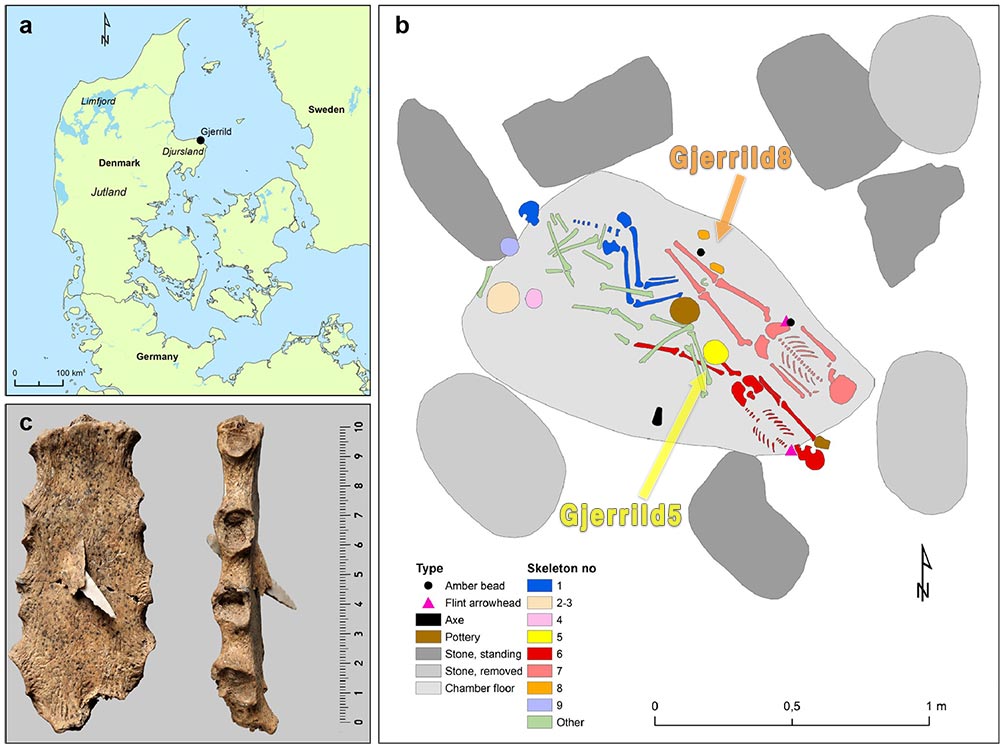
Late Single Grave culture
Unlike most of the classical SGC graves, the Gjerrild barrow contained a megalithic chamber, a so-called Bøstrup cist. These are large stone cists dated to the later part of the SGC (Ground and Upper Grave period, i.e. after 2600 cal. BCE) constructed with an entrance, which allowed for succeeding burials. The Bøstrup cists are almost exclusively found in northern and north-eastern Jutland and thus represent a later expansion of the SGC, north and east of the early core areas of central and western Jutland.
Middle Neolithic vs. Late Neolithic
Five of the six radiocarbon dates span 4007–3790 uncal BP, corresponding to 2575–2035 cal BCE after reservoir correction. Gjerrild 8 is the oldest of these skeletons, calibrated to 2575–2345 cal BCE (95.4%), whereas Gjerrild 5 is the youngest, calibrated to 2284–2035 cal BCE (95.4%). The dates suggest a main period of use from c. 2600/2500 to around 2200 cal BCE, confirming that the chamber was indeed used during the SGC epoch. We can now conclude that individuals 1, 6, 7 and 8 belong to the Ground and Upper grave periods, i.e. the middle and late parts of the SGC. This implies an earlier monument construction and a longer use period than the archaeological typology had indicated. The slightly younger date of individual 5 corresponds to the Late Neolithic in the chronology of Vandkilde (1996), or to the transition Middle/Late Neolithic in the chronology of Müller et al. (2012). The younger date for the loose mandible corresponds to the Early Bronze Age. The two males Gjerrild 6 and 7 have overlapping dates and may well be contemporary, while Gjerrild 8 is most likely earlier and Gjerrild 5 later.
Y-DNA and mtDNA
Gjerrild 5 and 8 were genetically identified as males and Gjerrild 1 as a female. The latter had been determined previously on osteological grounds, whereas Gjerrild 5 and 8 could not be assigned to sex based on osteology and are thus identified for the first time in this study. The mitochondrial haplogroup K2a was assigned for both Gjerrild 8 and 5 with high confidence (99%), while Gjerrild 1 was assigned HV0 (92% confidence). The Y-chromosome haplogroup of Gjerrild 5 was determined as R1b-V1636 (R1b1a2), a rare subclade of R1b.
Isotope analyses
The results from Gjerrild 1 indicate a completely terrestrial diet, while values from Gjerrild 6, 7, and the loose mandible has a limited marine signal. A rough estimate suggests a possible marine reservoir effect for these three individuals at c. 45–60 years, supposing a marine reservoir effect at 273±18 years for a fully marine diet. Gjerrild 5 and 8 represent children affected by lactation but should also have minimal reservoir effects.

Population genomics
It is evident that the Gjerrild individuals do not display the typical early/middle Neolithic ancestry which is observed among LBK, TRB and Globular Amphora Culture (GAC) groups. Rather, they genetically resemble individuals from Northern and Eastern Europe that post-date individuals connected with the Yamnaya migrations such as those related to the CWC, Battle Axe Culture and Unetice.
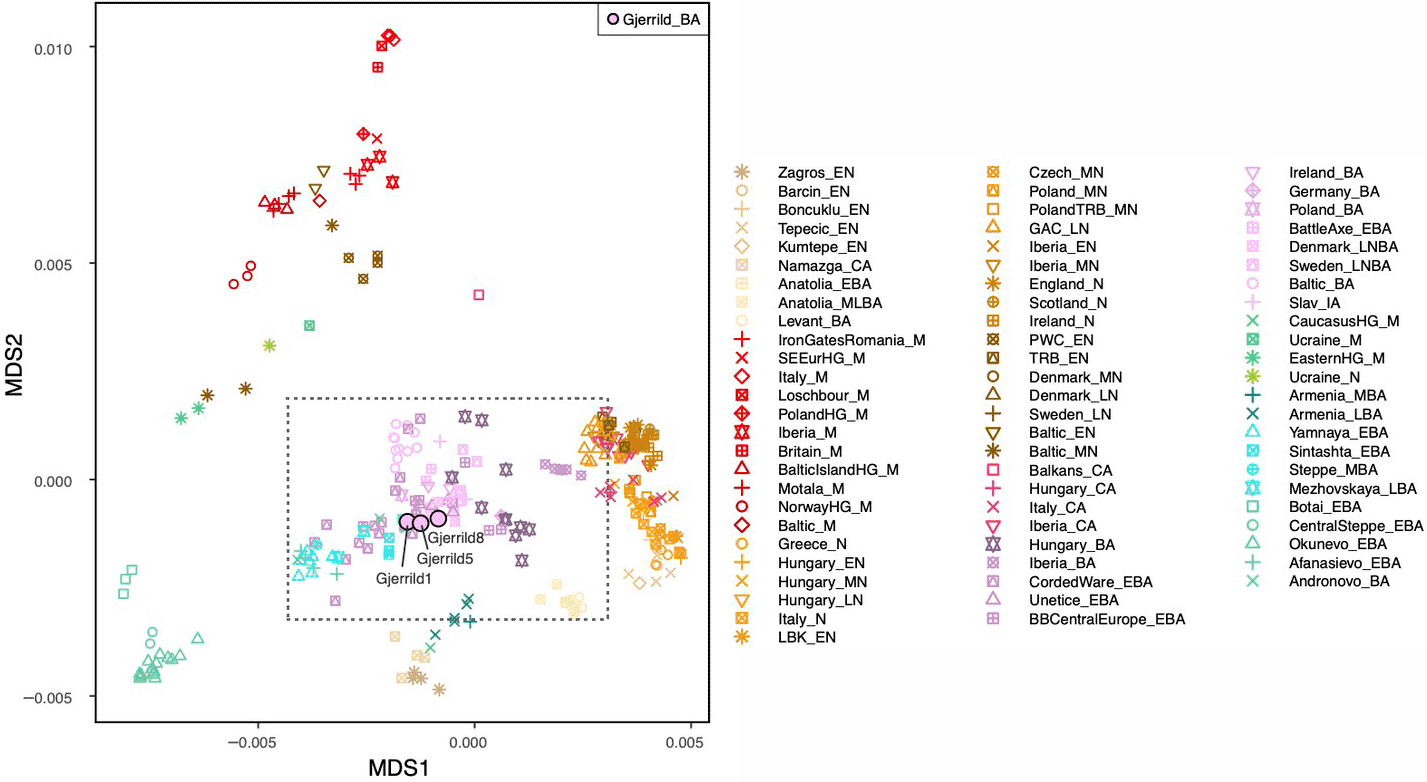
On a more fine-scale level, they cluster somewhat separated from the earliest individuals connected with CWC, which are found genetically closer towards individuals from the Steppe. The ADMIXTURE results confirms that all three Gjerrild individuals fall within the main “European Late Neolithic and Bronze Age” cluster, and correspondingly show Steppe-related ancestry components.
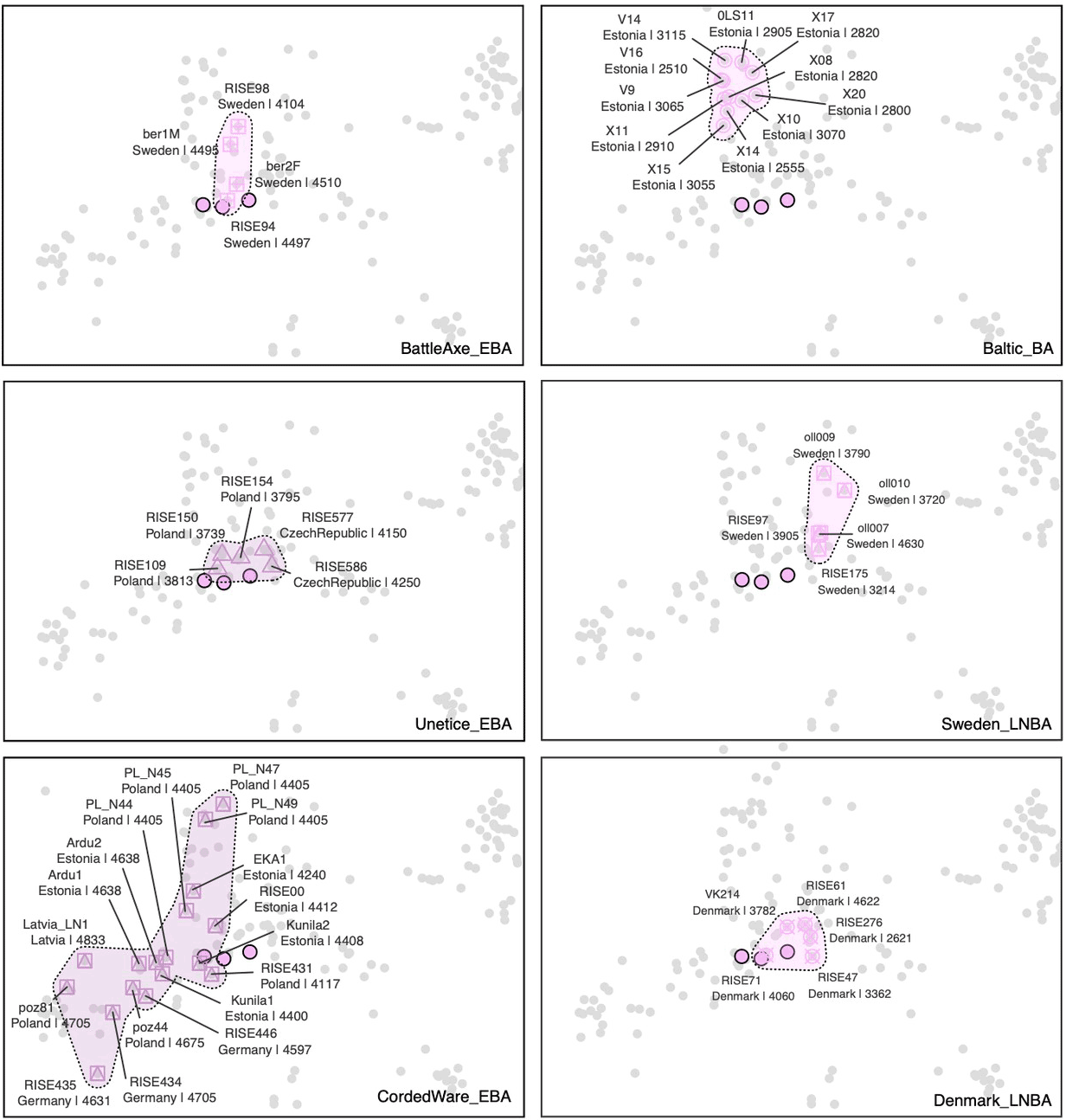
Earliest Indo-European lineage in Denmark
Evident data from the paper:
1. Despite the poor analyses available, SGC Gjerrild8 and LN Gjerrild5 show an LNBA ancestry unlike the early Corded Ware cluster richer in Steppe ancestry (including MN Gjerrild 1), and more similar to sample RISE61, an earlier Nordic MN (“Single Grave”) individual from Kyndeløse, of hg. R-Z284, with higher Neolithic-related ancestry – as is typical also of late Corded Ware groups from Sweden. This suggests that, as expected, the transition to the Late Neolithic was probably defined by an intrusion of peoples of a different ancestry.
2. Gjerrild 5 (2284-2035 calBC), like the earlier Gjerrild 8 (2575-2345 BC), was a child (Infans I, roughly 2 years old), and both show an isotopic signature different from the older skeletons, clearly over their previously defined baseline for Denmark in Frei et al. (2019), suggesting that they were both recent migrants. The Y-chromosome haplogroup (see below) and radiocarbon date of Gjerrild 5 are clearly in line with the expected intrusion of Yamnaya-derived Jutish Beakers.
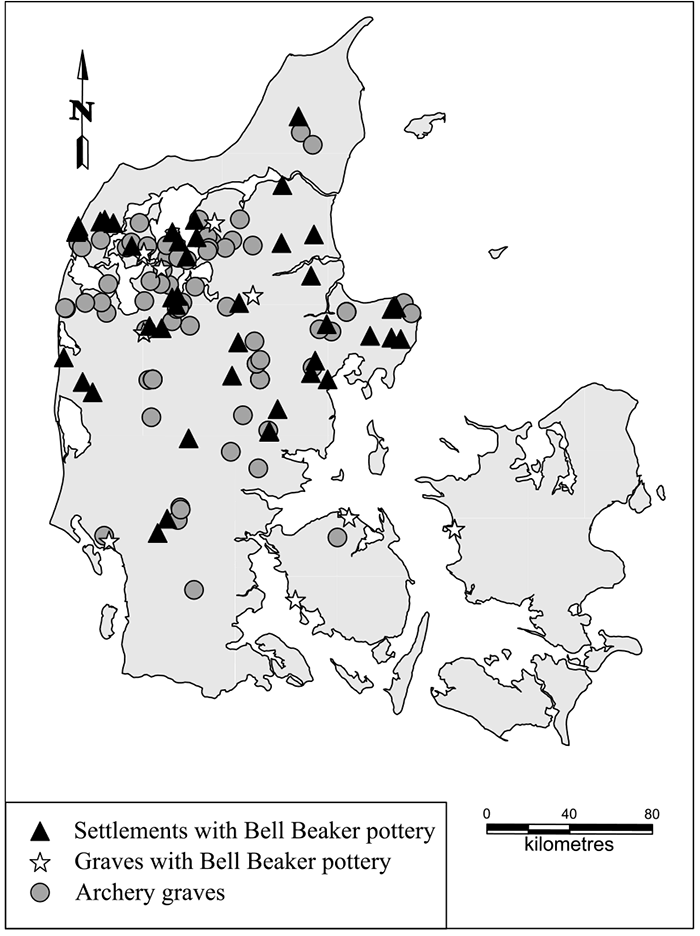
3. It is unclear whether RISE1281 belongs to a full-fledged R-V1636 lineage or not. Without the BAM files, it is impossible to say.
Based on the SNPs shared, I am assuming that (as is often the case) the authors did not care to add ancestral SNPs. The only SNP that makes the call dubious is Y125110 (G->A), where PG2001 shows an ancestral read whereas RISE1281 shows one derived.
As anyone with access to the development version of my dataset could see, Khvalynsk- and Yamnaya-related samples belong to an R1b-pre-V1636 haplogroup with a particular set of coincident positive and negative SNPs, whose formation date and TMRCA is impossible to ascertain, but – based on the estimates for R-V1636 proper, roughly coeval with the Late Repin period – it probably was related to its expansion in a similarly distant way (either directly or indirectly) as other R-M269 lineages were related to the bottlenecks under R-L23.
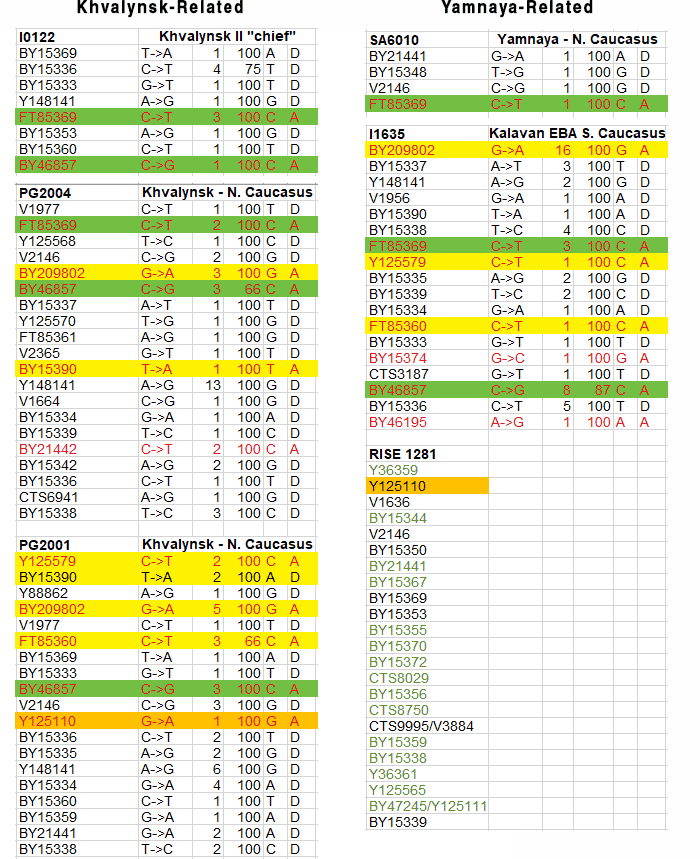
Without finding full-fledged R-V1636 samples in Yamnaya, we cannot say where the parent hg. R-V1636 (ancestor of all modern descendants) diversified, since there are important regions around the Caucasus without a proper geographical and chronological sampling, but I’d say that the steppes to the north of it are the most likely origin. If the Srubnaya individual I0233 from the Caspian-Aral region, of a possible R-V1636 subclade, is confirmed with other samples, a Steppe origin will be all but proven.
Much like R-Z2103, the presence of R(-pre?)-V1636 supports that bottlenecked Z2103 and L51 subclades common today in Northern Europe – like R-U106 or R-S1194 – were probably all derived from a Late Yamnaya/Early East Bell Beaker community from the Middle to Upper Danube with high variability in terms of Y-chromosome haplogroups, which contrasts with bottlenecked R1a-rich Pre-Corded Ware populations since (at least) the Late Trypillia period. In fact, R-U106 is essentially confirmed to have stemmed from the Carpathian basin (being already found in a southern Únětice group with a direct origin in the region), so it only remains to be clarified whether I1 was also present among early migrants of the Denmark Late Neolithic.
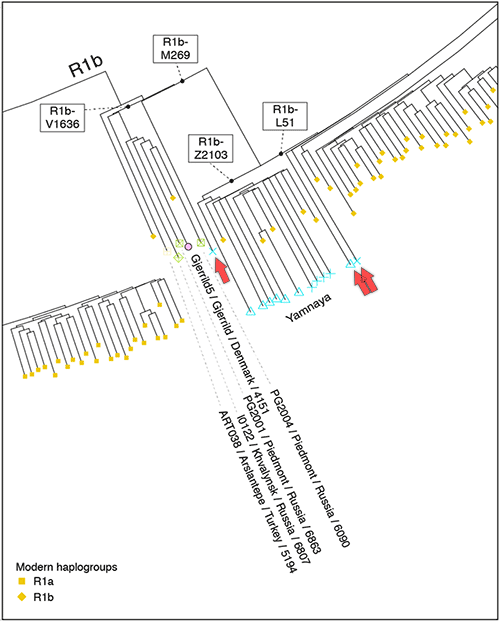
“Pre-I1” was already known to appear in Scandinavia during the Megalithic period and earlier, and “I1” (with some early surviving “pre-I1” samples) only after Steppe-related migrations – hence suggesting a local bottleneck during or immediately after the Bell Beaker maritime domination. However, the FamilyTreeDNA Haplotree team formed by phylogeneticist Michael Sager and Göran Runfeldt from the R&D team have already renamed almost all “pre-I1” samples as I-Z2699, which has left an interesting orphan, the Hungarian Iron Age sample (I20745_I20767), as the only currently true “pre-I1” individual, as far as I know. This, together with the possible appearance of “I1” (likely then also “pre-I1”) among non-IE and IE groups from France IA and Italy IA has boosted again the questions about a common origin of the I1 bottleneck in Yamnaya Hungary, as someone recently commented – hence similar to some J-L283 and G2a lineages – based on the presence of I-Z2699 in a Hungary LBK sample. I personally still see the local Southern Scandinavian bottleneck as more likely, although the survival of Yamnaya R-V1636 clans up to Scandinavia was certainly unexpected, so who knows.
The worst part of the paper is not only that it is sloppy in its discussion of a quite relevant finding for the likely intrusion of Jutish Beakers, a culture systematically ignored by Kristiansen and the Copenhagen group, but that – as Furholt rightly criticizes – for this research team the fixation with Yamnaya as an antecedent of Corded Ware (and with some weirdly nativist concept of “genetic continuity” in Northern European LNBA in general, and in Denmark LNBA in particular) seems to be the only premise, and everything else is just noise.
Related
- Predictions about the genetic change from Single Grave to the Late Neolithic in Denmark
- Proto-Indo-European kinship system and patrilineality
- The complexities of 3rd millennium Steppe-related migrations
- Yamnaya ancestry: mapping the Proto-Indo-European expansions
- European hydrotoponymy (III): from Old European to Palaeo-Germanic and the Nordwestblock
- Pre-Germanic and Pre-Balto-Finnic shared vocabulary from Pitted Ware seal hunters
- European hydrotoponymy (I): Old European substrate and its relative chronology
- European hydrotoponymy (II): Basques, Iberians, and Etruscans after Old Europeans
- Pre-Germanic and Pre-Balto-Finnic shared vocabulary from Pitted Ware seal hunters
- Bell Beaker/early Late Neolithic (NOT Corded Ware/Battle Axe) identified as forming the Pre-Germanic community in Scandinavia
- Minimal Corded Ware culture impact in Scandinavia – Bell Beakers the unifying maritime elite
- Pre-Germanic born out of a Proto-Finnic substrate in Scandinavia
- Kortlandt: West Indo-Europeans along the Danube, Germanic and Balto-Slavic share a Corded Ware substrate
- Reproductive success among ancient Icelanders stratified by ancestry
- Genomic analysis of Germanic tribes from Bavaria show North-Central European ancestry
- Germanic tribes during the Barbarian migrations show mainly R1b, also I lineages
- On Proto-Finnic language guesstimates, and its western homeland